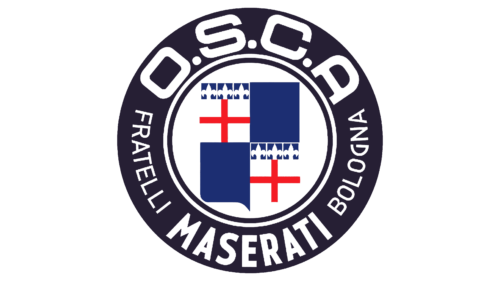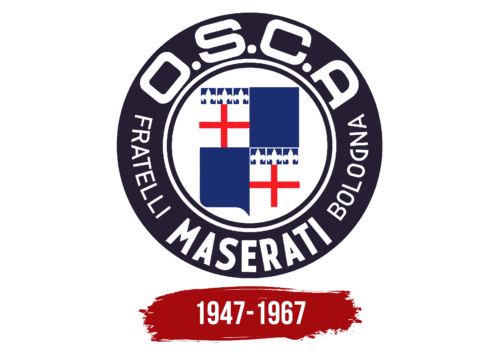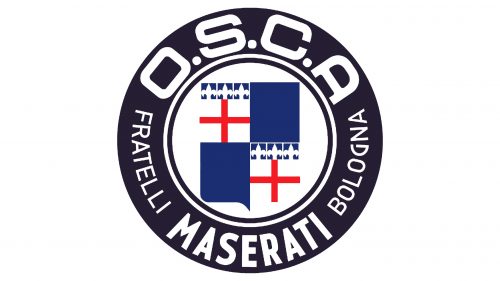The O.S.C.A. logo has made its mark in the history of Italian motorsport as a symbol of high quality and technological excellence. It embodies the innovative spirit of a company dedicated to outstanding engineering solutions and unique car designs.
O.S.C.A.: Brand overview
In San Lazzaro di Savena, close to Bologna, Italy, O.S.C.A. (Officine Specializzate Costruzione Automobili) was founded in 1947. The Maserati brothers—Ernesto, Ettore, and Bindo—founded the business after leaving their previous venture, Maserati, which they later sold to the Orsi family in 1937.
The Maserati brothers’ ambition to return to their heritage of building compact, highly capable racing and sports vehicles inspired them to form their new company. Under Orsi’s direction, they sought the creative freedom they had not enjoyed in their latter years at Maserati.
The 1948 Maserati Tipo 4, or MT4, was the first automobile produced by the brand. This lightweight sports car had an aluminum shell and a tubular frame. Its 1.1-liter engine could generate about 70 horsepower. Due to its exceptional handling and performance, racers and fans soon took notice of the MT4.
The company concentrated on creating and perfecting the MT4 during the ensuing years. Versions featuring 1.3- and 1.5-liter engines were produced, enabling the vehicle to participate in several racing classes successfully. The MT4 won several races, including the coveted Mille Miglia for its class.
A modified MT4 piloted by Stirling Moss and Bill Lloyd won the 12 Hours of Sebring outright in 1954, setting new records for the manufacturer and defeating more potent vehicles from Ferrari, Lancia, and Aston Martin. In the world of motorsport, this victory greatly enhanced their reputation.
The company increased the number of models in its lineup in the middle of the 1950s when it unveiled the 750S, an H-class racer with a 750 cc engine. This model was also successful, winning multiple class championships.
The 1600 GT, the first road car, was unveiled in 1957. This graceful coupe had a 1.6-liter engine that produced about 100 horsepower and was built by either Zagato or Fissore. The 1600 GT’s performance and stylish appearance won it numerous accolades.
The company started having financial issues in the late 1950s, despite their racing achievements and favorable reviews for their road cars. Due to low production quantities and expensive development expenditures, profitability declined.
The well-known motorcycle manufacturer MV Agusta is owned by Count Domenico Agusta, who purchased the brand from the Maserati brothers in 1963. The company continued to make automobiles under the new ownership but on a reduced scale.
Their final model was the mid-engined sports prototype, 1600 SP, created in 1963 for endurance racing. However, before production was stopped, very few units were constructed.
Twenty years later, in 1967, the company dissolved. About 1,000 cars were produced throughout its existence, most of which were race cars.
Vehicles were recognized for their exceptional handling, inventive technical solutions, and dependability. Numerous innovations created by the company were eventually incorporated into other sports cars made in Italy. These automobiles are now highly prized by collectors and fans of vintage automobiles. They frequently participate in historical races and exhibitions, bringing back fond memories of the heyday of Italian engineering and motorsport.
Meaning and History
What is O.S.C.A.?
The Maserati brothers sold their shares to the Maserati company and founded Officine Specializzate Costruzione Automobili. The brand specializes in producing limited-edition sports and racing cars for individual consumers. The company quickly made a name on the race track with its inventive lightweight design and other features. The company’s cars have performed excellently in motorsport competitions, such as the 24 Hours of Le Mans and the Formula 1 World Championship.
1947 – 1967
The O.S.C.A. logo appears simple due to its round shape, reflecting the understated practicality of a company that, in the mid-20th century, chose not to mimic the elaborate emblems of Porsche or Ferrari. Instead, it took a different path to showcase its individuality.
The automotive brand’s symbol consists of concentric circles, giving it the appearance of a roundel. Its colors—blue, red, and white—match the colors of the Bologna coat of arms, as O.S.C.A. was founded in this Italian province. Dark purple adds contrast, highlighting the light center and its colorful content.
At the center lies the most important part of the emblem—a slightly modified coat of arms of Bologna. It is based on a quadrilateral shield with a pointed base, divided into four parts. Two sections feature a red cross on a white background (Bologna’s flag) topped with three heraldic lilies, while the other two sections are entirely blue.
The car brand incorporated state symbols into its logo and placed them at the center to express love for its native province. The company’s patriotic spirit aimed to build trust among locals for the regional manufacturer and to bring fame to Bologna worldwide.
The city coat of arms is surrounded by a large dark purple ring filled with white inscriptions. Each word varies in size according to its importance.
- The largest is the abbreviation “O.S.C.A.,” derived from “Officine Specializzate Costruzione Automobili,” placed at the top to emphasize the brand’s significance.
- Slightly smaller is “MASERATI,” the surname of the brothers who founded O.S.C.A. Maserati was already famous worldwide then, so using its name in the new brand’s logo was a clever marketing move.
- The smallest words are “FRATELLI” (left) and “BOLOGNA” (right), providing information about who founded the brand and where.
Designers used several different sans-serif fonts in the emblem to distinguish text parts visually:
- A large geometric sans-serif font with square shapes is used for the top abbreviation, where “C” looks exactly like “O” except for a small gap on the right side.
- For “FRATELLI” and “BOLOGNA,” a thin, vertically stretched font, and for “MASERATI,” it’s a bold version.
The letters have many angles, highlighting the brand’s activity and desire to remain at the peak of fame. The rounded elements convey the swiftness of the cars and evoke a sense of softness and comfort. The fonts may seem outdated, given the time the logo was created, but they fully match O.S.C.A.’s bold and decisive character.





